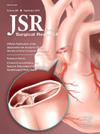评估早期非小细胞肺癌(NSCLC)患者跨性别和种族的临床结果
IF 1.8
3区 医学
Q2 SURGERY
引用次数: 0
摘要
虽然在肺癌患者中存在性别和种族/民族差异,但他们并没有研究这些不平等的界面。我们的目标是利用一个国家数据库来评估早期肺癌女性患者的临床结果和种族/民族群体之间的差异。方法查询2020年国家癌症数据库(NCDB)中2010 - 2019年已知生命状态的临床I期非小细胞肺癌(NSCLC)患者。排除类癌肿瘤患者。分析人口学资料、临床病理变量、30-d、90-d、5-y死亡率和5-y总生存率。结果符合纳入标准的患者共344223例,其中女性187588例(54.4%)。在种族亚群中,亚洲/太平洋岛民妇女(API)的5年生存率最高(77.8%)(P <;0.001)。API女性的手术切除率最高(75.7%),淋巴结检查率(73.1%)和淋巴结分期率(13.4%)较高(P <;0.001)。黑人和白人女性的5年生存率最低(60%,58.8%),手术切除率最低(59.1%,62.2%)(P <;0.001)。API女性的合并症最少(CCI = 0,71.1%;P & lt;0.001),高分化肿瘤发生率最高(28.7%,P <;0.001)。结论api患者生存率高,结样手术切除率高,肿瘤分级低。黑人和白人女性的总生存率和手术切除率最低。这种指南一致性手术的差异强调了承认早期非小细胞肺癌女性患者的种族/民族异质性的重要性,以及女性肺癌患者不应被视为整体治疗。本文章由计算机程序翻译,如有差异,请以英文原文为准。
Evaluating Clinical Outcomes Across Sex and Ethnicity in Patients With Early-Stage Non-small Cell Lung Cancer (NSCLC)
Background
Although there are well-studied sex and racial/ethnic disparities within lung cancer patients, they do not examine the interface of these inequities. We aim to utilize a national database to evaluate clinical outcomes and disparities within racial/ethnic groups of female patients with early-stage lung cancer.
Methods
The 2020 National Cancer Database (NCDB) was queried for patients with clinical stage I non-small cell lung cancer (NSCLC) with known vital status between 2010 and 2019. Patients with carcinoid tumors were excluded. Demographic data, clinicopathologic variables, 30-d, 90-d, 5-y mortality, and 5-y overall survival were analyzed.
Results
A total of 344,223 patients met the inclusion criteria, of which 187,588 were female (54.4%). Within ethnic subgroups, 5-y survival was highest among Asian/Pacific Islander women (API) (77.8%) (P < 0.001). API women had the highest rates of surgical resection (75.7%), with higher rates of nodes examined (73.1%) and nodal upstaging (13.4%) (P < 0.001). Black and White women had the lowest rates of 5-y survival (60%, 58.8%) and surgical resection (59.1%, 62.2%) (P < 0.001). API women had the least comorbidities (CCI = 0, 71.1%; P < 0.001) and highest rates of well-differentiated tumors (28.7%, P < 0.001).
Conclusions
API women had the highest survival rates, highest rates of surgical resection with nodal sampling, and low-grade tumors. Black and White women had the lowest rates of overall survival and surgical resection. This disparity in guideline-concordant surgery highlights the importance of acknowledging the racial/ethnic heterogeneity among women with early-stage NSCLC and that female lung cancer patients should not be treated as a monolith.
求助全文
通过发布文献求助,成功后即可免费获取论文全文。
去求助
来源期刊
CiteScore
3.90
自引率
4.50%
发文量
627
审稿时长
138 days
期刊介绍:
The Journal of Surgical Research: Clinical and Laboratory Investigation publishes original articles concerned with clinical and laboratory investigations relevant to surgical practice and teaching. The journal emphasizes reports of clinical investigations or fundamental research bearing directly on surgical management that will be of general interest to a broad range of surgeons and surgical researchers. The articles presented need not have been the products of surgeons or of surgical laboratories.
The Journal of Surgical Research also features review articles and special articles relating to educational, research, or social issues of interest to the academic surgical community.

 求助内容:
求助内容: 应助结果提醒方式:
应助结果提醒方式:


